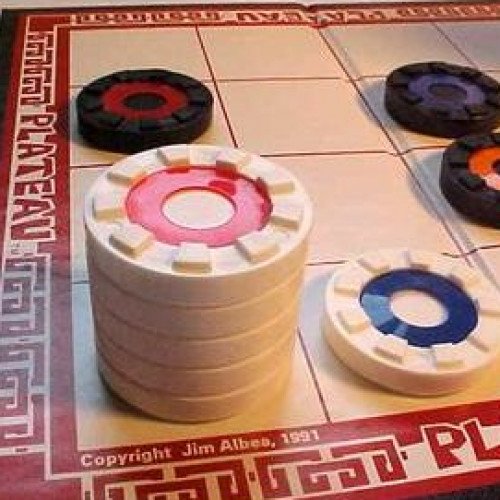PLATEAU VS SHATRANJ

PLATEAU
Plateau is a two-player abstract strategy board game invented by Jim Albea. The game was developed over a two-year period culminating in its present form on May 12, 1986. The original name for the game was Pinnacle, but it was discovered that an older board/card game had that name, so around 1989 the name was changed to Plateau. From the 1980s through the 1990s Plateau was played at Science Fiction conventions mostly in the Southeastern United States. From the 1990s to the present, the game is played live at an online game site and via email. In 1997 a computer implementation of the game was created which facilitates email play and has a computer robot. Onboarding is adding one new piece to the play. This new piece can be placed anywhere that doesn't directly harm an opposing piece. For instance, you can onboard to any blank square or on top of any of your own pieces. The majority of Plateau moves are onboards. Instead of Onboarding or Moving, a player can choose to spend his turn exchanging prisoners. Prisoners are exchanged using the point values of the pieces. A simple value-for-value system is used. Since the pieces range in value from 1 point (for the mute) to 21 points (for the Ace) there are usually several combinations and options available for the players. The player initiating the exchange selects the pieces he wishes to exchange. These pieces will all add up to some point value. The responding player then has four options depending on the point values of the prisoners that he holds.
Statistics for this Xoptio

SHATRANJ
Shatranj (Arabic: شطرنج; Persian: شترنج; from Middle Persian chatrang چترنگ) is an old form of chess, as played in the Sasanian Empire. Its origins are in the Indian game of chaturaṅga. Modern chess gradually developed from this game, as it was introduced to the western world by contacts in Muslim Al-Andalus (modern Spain) and in Sicily in the 10th century. The Persian word shatranj ultimately derives from Sanskrit (Sanskrit: चतुरङ्ग; caturaṅga) (catuḥ: "four"; anga: "arm"), referring to the game of the same name: Chaturanga. In Middle Persian the word appears as chatrang, with the 'u' lost due to syncope and the 'a' lost to apocope, such as in the title of the text Mâdayân î chatrang ("Book of Chess") from the 7th century AD. In Persian folk etymology, a Persian text refers to Shah Ardashir I, who ruled from 224–241, as a master of the game: Three books written in Pahlavi, Kar-Namag i Ardashir i Pabagan, Khosrow and ridag, and Wizārišn ī čhatrang ("Treatise on Chess"), also known as the Chatrang Nama ("Book of Chess"), all mention chatrang. In Kār-nāmak it is said that Ardashīr "with the help of the gods became more victorious and experienced than all others in polo, horsemanship, chess, backgammon, and other arts," and in the small treatise on Khosrow and ridag, the latter declares that he is superior to his comrades in chess, backgammon, and hašt pāy. Bozorgmehr, the author of Wizārišn ī čhatrang, describes how the game of chess was sent as a test to Khosrow I (r. 531-79) by the "king of the Hindus Dēvsarm" with the envoy Takhtarītūs and how the test was answered by the vizier Bozorgmehr, who in his turn invented the game Backgammon as a test for the Hindus. These three Middle Persian sources do not give any certain indication of the date when chess was introduced into Persia. The mentions of chess in Kar-Namag i Ardashir i Pabagan and Khosrow and ridag are simply conventional and may easily represent late Sasanian or even post-Sasanian redactions. According to Touraj Daryaee, Kar-Namag i Ardashir i Pabagan is from 6th century. Wizārišn ī čhatrang was written in the 6th century.